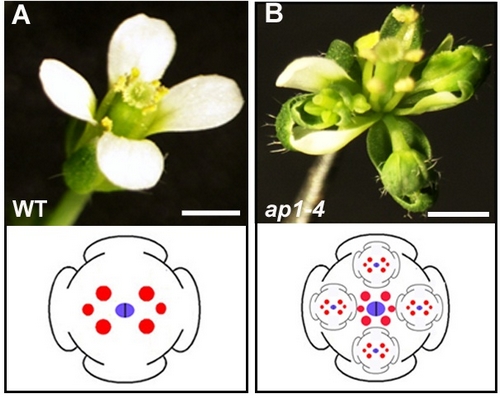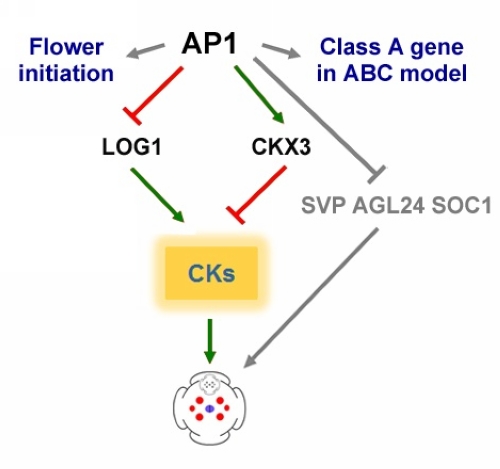Indeterminate growth of shoots continually produces new tissues from the dividing apical meristem. In contrast, determinate growth of the floral meristem produces flowers of a particular size and form by specification of floral organs and termination of stem-cell divisions in the meristem. To achieve this specification, floral organs do not form meristems in organ axils, although leaves can form axillary meristems and thus have reiterative developmental potential.
In Arabidopsis, initiation of the FM and specification of outer whorl organs require the floral homeotic gene APETALA1 (AP1) which belongs to MADS transcription factor family. AP1 also prevents the formation of flowers in the axils of sepals. The mechanisms of AP1 function in the floral transition and in floral organ patterning have been extensively studied, but how AP1 terminates sepal axil stem cell activities to suppress axillary meristems formation remains unsolved.
In a recent study, researchers from Yuling Jiao’s group, from the Institute of Genetics and Developmental Biology, Chinese Academy of Sciences, found that the classic floral homeotic gene AP1 directly regulates homeostasis of plant hormone cytokinins to inhibit the formation of sepal axil stem-cell niches. A deeper understanding of axil lateral meristem activity provides crucial information for enhancing yield by engineering crops that produce more elaborated racemes.
This work has been online published on
PNAS (DOI: 10.1073/pnas.1318532111), with graduate student Yingying Han as the first author. This research was supported by National Basic Research Program of China, National Natural Science Foundation of China, and the Chinese Academy of Sciences.

Figure 1. AP1 inhibits cytokinin signaling and reduces cytokinin levels in the FM (Image by IGDB). (A) Flower phenotype of ap1-4, (B) Flower phenotype of ap1-1

Figure 2. Model depicting AP1 suppression of sepal axil stem-cell activity through the inhibition of cytokinin biosynthesis (LOG1) and activation of cytokinin degradation (CKX3) to reduce active cytokinin levels in sepals. Elevated cytokinin levels activate sepal axil meristem activity to induce secondary flower formation. Cytokinin signaling also interacts positively and reciprocally with flowering-time MADS-domain genes. (Image by IGDB)
 Figure 1. AP1 inhibits cytokinin signaling and reduces cytokinin levels in the FM (Image by IGDB). (A) Flower phenotype of ap1-4, (B) Flower phenotype of ap1-1
Figure 1. AP1 inhibits cytokinin signaling and reduces cytokinin levels in the FM (Image by IGDB). (A) Flower phenotype of ap1-4, (B) Flower phenotype of ap1-1 Figure 2. Model depicting AP1 suppression of sepal axil stem-cell activity through the inhibition of cytokinin biosynthesis (LOG1) and activation of cytokinin degradation (CKX3) to reduce active cytokinin levels in sepals. Elevated cytokinin levels activate sepal axil meristem activity to induce secondary flower formation. Cytokinin signaling also interacts positively and reciprocally with flowering-time MADS-domain genes. (Image by IGDB)
Figure 2. Model depicting AP1 suppression of sepal axil stem-cell activity through the inhibition of cytokinin biosynthesis (LOG1) and activation of cytokinin degradation (CKX3) to reduce active cytokinin levels in sepals. Elevated cytokinin levels activate sepal axil meristem activity to induce secondary flower formation. Cytokinin signaling also interacts positively and reciprocally with flowering-time MADS-domain genes. (Image by IGDB) CAS
CAS
 中文
中文




.png)
